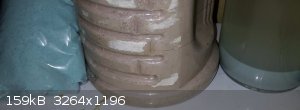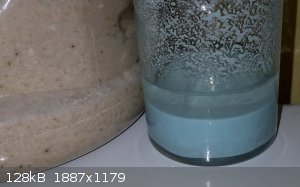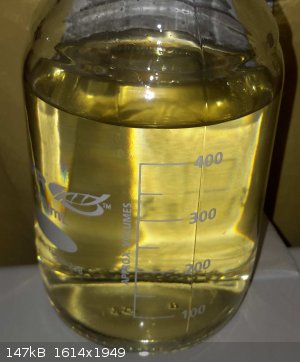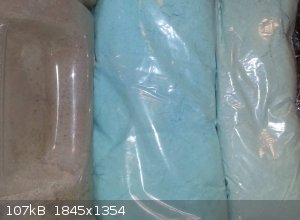RogueRose
International Hazard
    
Posts: 1593
Registered: 16-6-2014
Member Is Offline
|
|
200 proof alcohol (starting with 165 proof) with CuSO4 and MgSO4! SUCCESS! NO REFLUXING!!
So I've been putting off the testing until I had the proper equipment and I finally have this (good vacuum filter to remove EtOH left in Sulfate
powder).
So I measured out 250ml of ethanol that was probably 170 proof (temp was messed up and it showed 165, so it was probably a little higher). I took
some anhydrous CuSO4 that was as dry as I thought possible, it was dried in an oven a year ago and stored in air tight plastic container. It was
pinkish grey in color. I weighed out 150g of the substance that was fairly powdered with some small chunks about 1mm^3 (or smaller) as they weren't
dust. I added the powder as I swirled the alcohol in a media bottle and shook for 2 minutes every 3 minutes for about an hour. The color slowly
changed to blue/grey and slight heat was given off (about a 5-10 degree F rise in temp). Allowed to sit for 2-3 hours, came back and top 3mm layer
was blue but the bottom had changed very little. This was taking forever so I thought I'd try another bottle and change some things.
I used same 250ml and 150g of CuSO4 from the same bottle. I put the sulfate in a coffee grinder and turned into a very fine powder. I then added
the powder though ultra fine coffee filter (very fine brass mesh - and removed about 5g from the 150g total that wouldn't pass) funnel about 5-8g at a
time while swirling the liquid. The liquid got cloudy and somewhat blue as it was added and the powder turned a purpleish and tended to form a clump
and the bottom. Once totally added the temp had raised from 72F (both compounds) to about 130-140F and the color was homogenous. I microwaved in 30
second periods then shook for 15-20 seconds, repeat. It took about 10 minutes to get the sulfate to turn completely blue and the powder remained an
extremely fine powder that woudl clump in the bottom (one big block) but woudl break up with violent shaking. If it was room temp, it wouldn't break
up easily, at 120-160 it broke up with very little shaking.
Finally I did the last 350ml and 200g sulfate (in 1L media bottle) with same process but this time I heated the EtOH prior to adding the sulfate and
this procedure took about 1/2 the time and would boil the EtOH in the bottle (pressure wasn't a problem as it was thick glass and the iupper part
acted as a condenser b/c liquid only covered 1/2 bottle).
Once done with dehydrating, the color of the liquid had a slight yellow tint, somewhat like urine. I poured all into a funnel (EtOH & sulfate)
with a cotton filter at the bottom, used vacuum to pull everything through then passed back through 2x more. The yellow tint remained. I got about
650ml of 200 proof ethanol!.
I then powdered some AC, dumped into the bottle, shook and then passed through filter again 3x and ended up with crystal clear absolute ethanol!
This ethanol started with very old bottles (maybe 40-50 years old) of schnapps, 20+ year old beers (yes, Molson Ice beers at least 20 years old) and a
bunch of old wine bottles and boxes and some really rank liquors that no one would drink. All was distilled in a make shift setup where I started
with a 10.5% wash and would get 65% alcohol on the first run!second run I could get up to 185 proof but only for parts of the run, so it all evened
out to about 165-170 and it smelled like all the alcohols mixed together (REALLY rank - the oils must have carried over and the AC didn't remove
this).
This showed me how important the ingredients are in whatever alcholol you are making, especially a liquors as there are many flavors that come over
and seem impossible to remove. It makes me want to do this as a hobby but this stupid country won't allow it and charges extremely high amounts to
buy a permit to make small amounts every year. Even though tI don't drink it, it is a very fun and interesting craft in which to be involved!
I also tried drying 185 proof with anhydrous MgSO4. It wasn't a find dust/powder, but lots of small 1mm^3 pieces. I calculated amount needed and
added 2x the sulfate needed. After 15 months of sitting (and lots of shaking from time to time) I finally have 192 to 194 proof which isn't much of
an increase. I want to try again with powdered MgSO4 & hot ethanol and i think I will have success as well.
So, this is an easy process without haveing to reflux which I think can save a lot of time unless you really need to distill. I'm wondering how much
CuSO4 is in my alcohol so I'm going to distill the solution and see what residue is left over. l
This is with 97% to 100%, so the right hand bottle shows that it isnt' blue like the next pic because it doesn't have enought water to absorb

The right bottle is with the saturated Cuso4 making the pentahydrate

This shows the yellowish color (picture makes it look MUCH worse) or the EtOH after filtered from the CuSO4. Activated Carbon removed this very
easily!

This is the final reacted CuSO4. The far right was used to dry 97% EtOH and had excess sulfate, so it isn't fully hydrated while that in the middle,
should be fully hydrated to the pentahydrate (or a mix of pentahydrate and lower hydrates). The far left is the anhydrous. I believe it is that
color because it was dehydrated by heating. I would like to try heating under vacuum as this should lower the temp needed and possibly give the pure
white color which I find desireable.
There was a fair amount of EtOH in the sulfate powder even after vacuum at -715 Torr and the smell was very appearant upon heating. The powder seemed
to be even more fine than what I put into the 170 proof alcohol, so I think the process helps break down the crystal structure and give ultra-fine
particulates. IDK if this could be useful in any applications other than quick dissolution into a solvent.

[Edited on 2-24-2018 by RogueRose]
[Edited on 2-24-2018 by RogueRose]
[Edited on 2-24-2018 by RogueRose]
|
|
|
aga
Forum Drunkard
    
Posts: 7030
Registered: 25-3-2014
Member Is Offline
|
|
Sounds like you've been doing a lot of work to get superbooze 
How are you measuring the 'proof' ?
|
|
|
RogueRose
International Hazard
    
Posts: 1593
Registered: 16-6-2014
Member Is Offline
|
|
Quote: Originally posted by aga  | Sounds like you've been doing a lot of work to get superbooze 
How are you measuring the 'proof' ? |
One of those glass stick hydrometers. I'm sure that it isn't the perfect measurement insturment as I actually got about 101% so I'm thinking it is
pretty close. I guess the next step is to get a refractometer? Is that what is used to to measure alcohol as well?
Getting 100% ethanol has been a goal for some time, especially without an advanced distillation setup. My still was cobbled together for $8 with
parts from a thrift store along with some JB weld and vinyl tubing for feeding water to the condensor.
|
|
|
aga
Forum Drunkard
    
Posts: 7030
Registered: 25-3-2014
Member Is Offline
|
|
Yes, an ethanol refractometer will tell you more accurately what the w% of EtOH is.
If you buy one, make sure it is specifically for ethanol, as many other types exist (e.g. for sugar etc).
Mine has a log-type scale which is more accurate at lower EtOH concentrations, so samples need diluting accurately to get the measurement more
precise.
If you already have any, the potassium permanganate test is quite good.
|
|
|
Sulaiman
International Hazard
    
Posts: 3696
Registered: 8-2-2015
Location: 3rd rock from the sun
Member Is Offline
|
|
I bought a set of alcohol hydrometers like this https://www.ebay.co.uk/itm/3PCS-Hydrometer-Alcohol-Meter-Tes... OUAAOSwa3BaHkn1 OUAAOSwa3BaHkn1
they seem very accurate.
I just checked eBay and there are even cheaper sellers.
CAUTION : Hobby Chemist, not Professional or even Amateur
|
|
|
RogueRose
International Hazard
    
Posts: 1593
Registered: 16-6-2014
Member Is Offline
|
|
I have two meters like the one in the kit, one for sugar and one for alcohol. I'm looking for a meter with a crystal/prism and or mirror that does
something with light to show the exact alcohol content. I think it can do a number of other substances as well like vinegar, sugar and some others.
|
|
|
Magpie
lab constructor
    
Posts: 5939
Registered: 1-11-2003
Location: USA
Member Is Offline
Mood: Chemistry: the subtle science.
|
|
Quote: Originally posted by RogueRose  |
Once done with dehydrating, the color of the liquid had a slight yellow tint, somewhat like urine. I poured all into a funnel (EtOH & sulfate)
with a cotton filter at the bottom, used vacuum to pull everything through then passed back through 2x more. The yellow tint remained. I got about
650ml of 200 proof ethanol!.
I then powdered some AC, dumped into the bottle, shook and then passed through filter again 3x and ended up with crystal clear absolute ethanol!
|
Very nice work! I use CaO and 3A sieves to get ethanol at <100 ppm water starting from Everclear (190 proof). Your method seems much simpler.
You have inspired me to publish my method in Prepublication for comparison.
The single most important condition for a successful synthesis is good mixing - Nicodem
|
|
|
aga
Forum Drunkard
    
Posts: 7030
Registered: 25-3-2014
Member Is Offline
|
|
That's the point - it has to be calibrated for the substance you want to measure.
Mostly they're the same prism device for all the different things they can measure.
|
|
|
FireLion3
Hazard to Others
  
Posts: 218
Registered: 11-1-2014
Member Is Offline
Mood: No Mood
|
|
Just a little tip... near 200 proof ethanol can be had by distilling ethanol under a controlled vacuum. I believe you have to get the BP down to
around 33-37 Celsius, and the ethanol that comes over is around 99.97% pure or something like that. Easily achievable with an aspirator. Varying
extents of vacuum effect the azeotrope. There's a chart floating around somewhere for this, but I don't have it off hand.
[Edited on 25-2-2018 by FireLion3]
|
|
|
Sulaiman
International Hazard
    
Posts: 3696
Registered: 8-2-2015
Location: 3rd rock from the sun
Member Is Offline
|
|
I thought high pressure is required to get better than 95% by distillation,
if 99.97% can be distilled over at low pressure I am very interrested.
(so would many many others)
Any chance that you could find such a reference ?
CAUTION : Hobby Chemist, not Professional or even Amateur
|
|
|
happyfooddance
National Hazard
   
Posts: 530
Registered: 9-11-2017
Location: Los Angeles, Ca.
Member Is Offline
Mood: No Mood
|
|
FireLion3 is correct about that. The temperature is closer to like 17° Celsius though, it works out to something like 60 torr.
It is very time-consuming, though.
|
|
|
aga
Forum Drunkard
    
Posts: 7030
Registered: 25-3-2014
Member Is Offline
|
|
ISTR that a pressure-swing distillation is required to break the azeotrope.
Turns out that this site has some data on the effect of the pressure on the azeotrope:
http://www.hyper-tvt.ethz.ch/distillation-azeotrope-pressure...
|
|
|
happyfooddance
National Hazard
   
Posts: 530
Registered: 9-11-2017
Location: Los Angeles, Ca.
Member Is Offline
Mood: No Mood
|
|
According to the link aga posted, 70, not 60 torr. So I was close. 
But I have done it before. Dry(ish) ethanol comes over at about 17°, IME. Stuff that comes over at 19° has too much water to be worth the effort.
MgSO4 dries better... A good water aspirator can do it, but a not-so-good one can't. I actually have two aspirators that are the same make (Nalgene),
and one can pull dry alcohol, and the other can't. So it's that fine line of 70 torr, I guess.
All things considered, CaO does a way better job for cheaper. You can distill the final product on an oil bath in a quarter of the time.
|
|
|